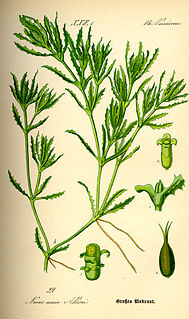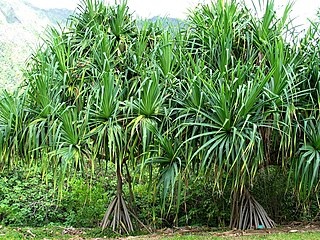
Garryaceae is a small family of plants known commonly as the silktassels. It contains two genera:

Lycopodium clavatum is the most widespread species in the genus Lycopodium in the clubmoss family.

Najas, the water-nymphs or naiads, is a genus of aquatic plants. It is cosmopolitan in distribution, first described for modern science by Linnaeus in 1753. Until 1997, it was rarely placed in the Hydrocharitaceae, and was often taken as constituting the family Najadaceae.

Pandanaceae is a family of flowering plants native to the tropics and subtropics of the Old World, from West Africa through the Pacific. It contains 982 known species in five genera, of which the type genus, Pandanus, is the most important, with species like Pandanus amaryllifolius and karuka being important sources of food. It is an ancient family dating from the early to mid-Cretaceous. This is a family that is not-well studied.

Magnolia champaca, known in English as champak, is a large evergreen tree in the family Magnoliaceae. It was previously classified as Michelia champaca. It is known for its fragrant flowers, and its timber used in woodworking.

Amaranthus crispus is a species of flowering plant in the family Amaranthaceae. It is referred to by the common name crispleaf amaranth. It is a herbaceous, sparsely pubescent annual plant. It can grow up to 0.5 m (1.5 ft) in height. It flowers in summer to fall. It usually grows in waste places, disturbed habitats, or near water. It is native to Argentina, Chile and Uruguay and has been introduced into Australia, Austria, Bulgaria, Crimea, Czechoslovakia, France, Hungary, Italy, Romania, Sardinia, the United States, and Yugoslavia.

Butomus is the only known genus in the plant family Butomaceae, native to Europe and Asia. It is considered invasive in some parts of the United States.

Boenninghausenia is a monotypic plant genus in the family Rutaceae. The sole species is Boenninghausenia albiflora, which occurs in Bhutan, Nepal, Pakistan, Kashmir, India, Indonesia, Philippines, Myanmar, Thailand, Laos, North Vietnam, China and Japan.
Flora of China is a scientific publication aimed at describing the plants native to China.

Najas guadalupensis is a species of aquatic plant known by the common names southern waternymph, guppy grass, najas grass, and common water nymph. It is native to the Americas, where it is widespread. It is considered native to Canada, and most of the contiguous United States, Mexico, Central America, the West Indies and South America. It has been introduced in Japan, Israel and Palestine.

Najas marina is a species of aquatic plant known by the common names spiny water nymph, spiny naiad and holly-leaved naiad. It is an extremely widespread species, reported across Europe, Asia, Africa, Australia, the Americas and many oceanic islands. It can be found in many types of freshwater and brackish aquatic habitat, including bodies of alkaline water.

Tofieldia is a small genus of flowering plants described as a genus in 1778. It is widespread across much of Europe, Asia, and North America.

Blyxa is a genus of an aquatic plant of the family Hydrocharitaceae described as a genus in 1806.
Najas filifolia, the needleleaf waternymph, is an aquatic plant in the Hydrocharitaceae. It is a rare and little-known species, known from only three counties (Decatur County, Georgia; Santa Rosa County, Florida; and Leon County, Florida. It is unusual in the genus in bearing fruits that are recurved to crescent-shaped.
Najas wrightiana is a species of aquatic plant in the Hydrocharitaceae family. It is referred to by the common name Wright's waternymph, and is found in lakes and streams. It is native to Mexico, Guatemala, Belize, Honduras, the Bahamas, Cuba, and Venezuela. It is also considered introduced and naturalized in southern Florida.

Najas gracillima, the slender waternymph, is a submerged species of aquatic plant in the Hydrocharitaceae family. found in lakes and streams. It is native to China, Russian Far East, Japan, Korea, Taiwan, Iran, Alberta, Ontario, Newfoundland, Nova Scotia, New Brunswick, the eastern United States. It is also considered introduced and naturalized in France, Spain, Italy and California.
Najas pseudogracillima, called the Hong Kong water nymph, is an aquatic plant growing in fresh water ponds. It is a rare and little-known species known from one collection from a pond on the campus of Chung Chi College at the Chinese University of Hong Kong. It is very similar to N. gracillima except that the male inflorescences lack a spathe.

Cynoglossum zeylanicum, also called the Ceylon hound's tongue, Ceylon forget-me-not, and Indian hound's tongue, is a species of flowering plant in the family Boraginaceae. It is found throughout Asia. It has also been introduced to the Americas.
Najas tenuissima is a species of flowering plant belonging to the family Hydrocharitaceae.













